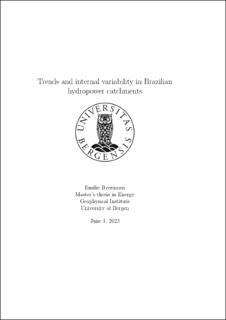| dc.description.abstract | Hydropower is a major energy source in Brazil, and long-term hydropower production planning is crucial both for maintaining energy and water security in the country. The amount of water that is available to electricity production in the reservoirs have changed in the recent years, and there is an urgent need to understand the cause(s) of these changes, and whether observed stream flow trends will persist, reverse or amplify in the future. In this thesis, I therefore separate externally forced precipitation and evaporation trends and variability from internal variations originating in the ocean for three hydrographic catchments in Brazil: Óbidos catchment in Amazon, Propria catchment in São Francisco and Porto Murtinho catchment in Paraguay. I compare an ocean anomaly assimilation experiment of Norwegian Climate Prediction Model (NorCPM) to an externally forced historical experiment and observed stream flow, precipitation and evaporation in the catchments. The results indicate that the multi-decadal increasing stream flow trend in Amazon is (partly) externally forced, and might therefore persist, but that the SON stream flow is tightly connected to JJA precipitation variation which is shown to be driven by ocean variation, and may therefore reverse in the future. The long-term decrease of precipitation in São francisco is likely to be caused by internal variability, and is therefore likely to (partly) restore in the future, but results indicate that decadal stream flow variations in the basin is substantially impacted by other factors than precipitation as well. São Francisco catchment is found to be strongly connected to DJF precipitation variations that the model is unable to replicate. In Paraguay, I find that the austral summer stream flow is tightly connected to inter-annual precipitation variability that originates in the ocean in austral winter and spring. The steep significant decrease in stream flow over the last decades in Paraguay catchment is likely to have additional causes than precipitation, according to the results. All the results have implications for hydropower and water management planning in the three catchments in Brazil. | |
